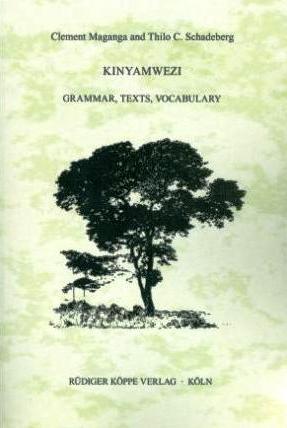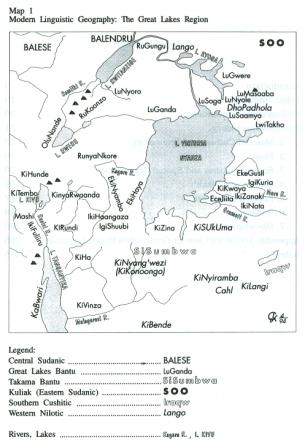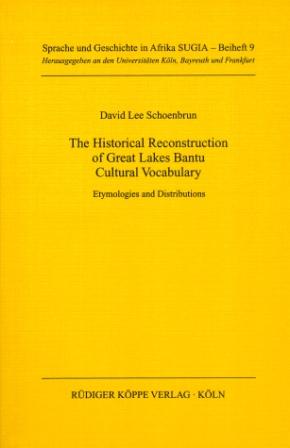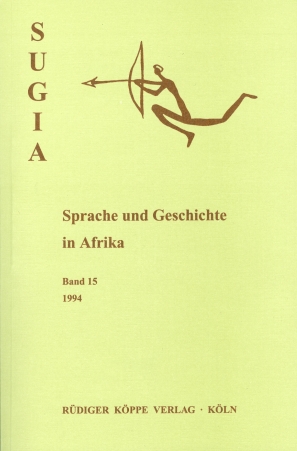



Kinyamwezi
Grammar, Texts, Vocabulary
Author: Clement Maganga †, Thilo C. Schadeberg. Series edited by: Bernd Heine, Wilhelm J.G. Möhlig †.
Series: EALD East African Languages and Dialects Volume 1
1992325 pp.
glossary
Text language(s): English
Format: 155 x 230 mm
580 g
Paperback
€ 69.80
Buy 'Kinyamwezi' as a downloadable PDF document directly from our online shop »
Order 'Kinyamwezi' as print edition »
Kinyamwezi is a Bantu language (F.22) of Western Tanzania and the mother tongue of at least one million people. There does not seem to be any strict linguistic border which would separate it from its northern neighbour Kisukuma. Speakers are aware of this dialect continuum, but recognize that Nyamwezi and Sukuma are two distinct ethnic identities, each with its own language. The dialect described here is the variety of Kinyamwezi spoken in the area of Ndala (Nzega District), and the mother tongue of one of the authors.
The book deals with the phonology, tonology and morphology. It consists of 5 parts: Part 1 introduces in detail the consonant and the vowel inventory and also the tonal system. Parts 2 and 3 discuss inflectional and derivational morphology. Part 4 presents a collection of texts with a close interlinear translation, and part 5 consists of a vocabulary Kinyamwezi-English / English-Kinyamwezi (see the complete table of contents at the bottom).
Undr these links you will find publications by Thilo Schadeberg, an analysis of the cultural vocabulary of the Great Lakes Bantu languages (Uganda / Rwanda / Tanzania) and a couple of grammatical descriptions, dictionaries and text collections of them:
Accompanying material:
- A Modern Runyoro-Rutooro Grammar (J.10)
(ISBN 978-3-89645-023-4 ) - Domains and Regions in Bantu Tense and Aspect
(ISBN 978-3-89645-772-1 ) - Igikuria Phonology and Morphology (E.40)
(ISBN 978-3-89645-029-6 ) - Issues in Bantu Tonology
(ISBN 978-3-89645-033-3 ) - Legenden, Märchen und Fabeln aus Ruanda
(ISBN 978-3-89645-743-1 ) - Phonology and Morphology of Ekegusii (E.42)
(ISBN 978-3-89645-026-5 ) - Relative Clauses in Luganda (E.15/J.10)
(ISBN 978-3-89645-020-3 ) - SUGIA Sprache und Geschichte in Afrika
(ISBN 978-3-89645-090-6 ) - Tales, Fables and Narratives of Rwanda
(ISBN 978-3-89645-745-5 ) - The Ha Language of Tanzania
(ISBN 978-3-89645-027-2 ) - The Historical Reconstruction of Great Lakes Bantu Cultural Vocabulary
(ISBN 978-3-89645-095-1 ) - Wörterbuch Kinyarwanda–Deutsch
(ISBN 978-3-89645-588-8 )
Cross-reference:
- A Sketch of Swahili Morphology
(ISBN 978-3-927620-16-2 ) - A Sketch of Umbundu (R.11)
(ISBN 978-3-927620-15-5 ) - Ekoti – The Maka or Swahili Language of Angoche
(ISBN 978-3-89645-025-8 ) - Nuba Mountain Language Studies
(ISBN 978-3-89645-427-0 ) - Tira and Otoro
(ISBN 978-3-89645-173-6 )
Reviews
En rédigeant leur ouvrage sur le kinyamwezi, langue bantoue parlée en Tanzanie (ouest), les auteurs [...] se sont donnés pour but de présenter les principaux aspects grammaticaux et lexicaux de la langue à partir de l’ensemble des données récoltées. Leur dessin n’est pas d’approfondir des questions de méthode ou de théorie linguistique ni de faire une étude comparative. Pourtant, la description du kinyamwezi est d’une très grande richesse et fournit bien plus qu’un simple inventaire des caractéristiques grammaticales et lexicales de la langue. [...]
Pour conclure, cette étude du kinyamwezi est d’une qualité exceptionnelle aussi bien par ses analyses minutieuses que par la richesse des données. Elle constitue un instrument indispensable pour celui qui s’intéresse aux langues de la zone F (cf. Guthrie) et est un ouvrage exemplatif pour tous ceux qui veulent entamer une description d’une langue bantoue.
Pascale Hadermann in Anthropos, 89/1994, 288-289
PDF documents:
 | Table of Contents | (≈ 49 kB) |
| « back | Print version | [top] |
 Books
Books Audio
Audio Biographies
Biographies Series
Series Festschrifts
Festschrifts Journals
Journals